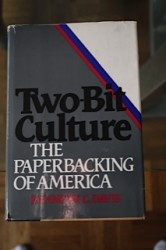
Two-Bit Culture: The Paperbacking of America by Kenneth C. Davis (1984, Houghton Mifflin (Photo© 2013 Kenneth C. Davis)
UPDATE January 28, 2024
Marc Jaffe, the editor cited below, died on December 31, 2023. He was 102 years old. I knew Marc Jaffe as a kind and generous gentleman. He must be counted as on of the most significant figures in recent publishing history, central to the Paperback Revolution and the enormous changes in publishing that it created.
Readers of a new biography of J.D. Salinger may find the new book’s plain, all-type cover somewhat recognizable. It is certainly designed with a nod to the Bantam Books’ mass market paperback edition of Salinger’s famous novel – a cover that was familiar to a generation of readers.
But that all-type cover was not Salinger’s first paperback cover. And therein lies a fascinating piece of publishing history: J.D. Salinger as Art Director.
This is a story I recounted in my book Two-Bit Culture: The Paperbacking of America, a history of the American paperback business and especially the “Paperback Revolution” of the Fifties and Sixties. The book was published in 1984 by Houghton Mifflin.
[The following excerpt is from Two-Bit Culture: The Paperbacking of America, Houghton Mifflin, 1984, pages 202-204]
J. D. Salinger was born in New York City in 1919, attended public schools, a military academy and three colleges; he served in the army from 1942 to 1946. Salinger had been writing stories since he was fifteen and was already familiar to New Yorker readers when The Catcher in the Rye was published by Little, Brown in 1951 and became a Book-of-the-Month Club selection. After winning wide –not unanimous— critical acclaim, the novel made it to the best-seller list in The Publishers’ Weekly and stayed there for five months, although not selling well enough to make it as one of the year’s ten top-selling novels. (On the best-seller list along with Salinger’s novel were Herman Wouk’s The Caine Mutiny, Nicholas Monserrat’s The Cruel Sea, James Jones’s From Here to Eternity, and William Styron’s Lie Down in Darkness.) New American Library had purchased paperback rights in advance of publication, as Victor Weybright later recounted:
“One Friday afternoon I had received an advanced copy of J.D. Salinger’s Catcher in the Rye. I read it that evening and went into a cold sweat lest the reprint rights should be seized by a competitor if I waited until Monday morning. I tracked (Little, Brown publisher} Arthur Thornhill down on the telephone, made a deal and discovered later that we had beaten the field, most of whom did not receive their advance copies until (the) Monday or Tuesday following.” [1]
Having propelled Weybright into such a fevered paroxysm, the slim volume about sixteen-year-old Holden Caulfield and his 48-hour quixotic revolt against “phoniness” appeared in a 25-cent Signet edition with a first printing of 350,000 copies in April of 1953. A box on the cover read, “This unusual book may shock you, will make you laugh, and may break your heart—but you will never forget it.” For Signet and thirty years of readers to come,[2] that statement was largely true.
Few people were disappointed or unhappy about the book. Save one: J.D. Salinger.
Marc Jaffe (still an NAL editor at this point), who had been in communication with Salinger, recalled that the writer came to NAL’s offices to discuss the book prior to its paperback appearance.
“He said he would be much happier if the book had no illustrated cover at all. In fact, he would be happier if the book was distributed in mimeographed form. Of course, he had no control over the cover.”
Kurt Enoch, who was then responsible for covers, assigned NAL’s star artist, James Avati, to paint the cover for The Catcher in the Rye. Avati produced a simple but effective illustration that showed Holden, wearing his famous red hunting hat turned backward and carrying his Gladstone bag, walking along a city street. He was passing in front of a nightclub that had some posters of semidressed women out front and Avati was asked to dress them up a bit, even though they were in the background. It was a most inoffensive cover, yet Salinger was dismayed by it. As Jaffe explained,
“The book went on to tremendous success, but even knowing that Salinger was unhappy, NAL never changed that cover. When the license came up for renewal, I was at Bantam and it became known he was unhappy.”
Oscar Dystel, by then the head of Bantam, recalled that Little, Brown’s Arthur Thornhill (who was on the Bantam board of directors) called to tell him of Salinger’s difficulties with NAL.
“He asked me if I might be interested in discussing Salinger. I said, ‘I’ll be on the next airplane.’ I dropped everything, went to Boston, and asked Arthur what he wanted. We shook hands on a two-cent-per-book royalty and Arthur then told me that Salinger had to approve the cover. I said, ‘Anything he wants. We’ll do it on plain brown paper.’ Salinger actually sent us a swatch to show us the color he wanted. He even selected the typeface. The J and the D were set in different types. Bantam still uses that cover.”
(Note: When I quoted Oscar Dystel, Bantam still held the paperback rights to The Catcher in the Rye. They have since reverted to Little, Brown, the original hardcover publisher, which now publishes the paperback edition of the book with its original 1951 hardcover jacket art.)
And by the way, more than 60 years after it appeared in print, The Catcher in the Rye remains among the “Most Banned and Challenged Books,” according to the American Library Association , which tracks attempts to remove books from school and public libraries.
[1] Victor Weybright, The Making of a Publisher (New York: Reynal & Company, 1966, p. 242.
[2] This was written in 1983, a little more than 30 years after the original publication of The Catcher in the Rye.